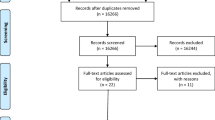Abstract
Psychiatric patient assaults on staff victims are a worldwide occupational hazard. This paper reports on a 15-year study of the characteristics of staff victims of patient assaults and a crisis intervention procedure to ameliorate the aftermath of theses incidents. The debate on the efficacy of early interventions is outlined and the present 15-year findings are presented, findings demonstrating remarkable consistency in victim characteristics over time. The crisis intervention procedures were associated with sharp declines in disrupted victim functioning. The validity of the study’s findings are noted and the implications for enhanced risk management training and staff victim crisis intervention procedures are discussed.
Similar content being viewed by others
References
Davis S: Violence in psychiatric patients: A review. Hospital and Community Psychiatry 42:585–590, 1991
Flannery RB Jr, Hanson MA, Penk WE: Risk factors for psychiatric inpatient assaults on staff. Journal of Mental Health Administration 21:24–31 1994,
Busch AB, Shore MF: Seclusion and restraint: A review of the literature. Harvard Review of Psychiatry 8:261–270, 2000
Flannery RB Jr: Characteristics of assaultive psychiatric inpatients: Updated review of findings, 1995–2000. American Journal of Alzheimer’s Disease and Other Dementias 16:153–156, 2001
Flannery RB Jr: Characteristics of staff victims of psychiatric patient assaults: Updated review of findings, 1995–2001. American Journal of Alzheimer’s Disease and other Dementias 19:35–38, 2004
Blair DT: Assaultive behavior: Does provocation begin in the front office? Journal of Psychosocial Nursing 29:21–26, 1991
Hansen W: Workplace violence in the hospital psychiatric setting: An occupational health perspective. American Association of Hospital Nurses Journal 44:575–580, 1996
California Health and Safety Code Sections 1257.7 and 1257.8, 1993
Revised Code of Washington 49.19.020, 1999
Occupational Safety and Health Administration: Guidelines for Preventing Workplace Violence in Health Care and Social Service Workers. Publication #3148. Washington, DC: United States Department of Health and Human Services, 1996
McPhaul KM, Lipscomb JA: Workplace violence in health care: Recognized but not regulated. Online Journal of Issues in Nursing 30:7, 2004
Flannery RB Jr: The Assaulted Staff Action Program: Coping with the Psychological Aftermath of Violence. Ellicott City, MD: Chevron Publishing, 1998
Flannery RB Jr, Stone P, Rego S, et al.: Characteristics of staff victims of patient assault: Ten year analysis of the Assaulted Staff Action Program (ASAP). Psychiatric Quarterly 72:237–248 ,2001
Everly GS Jr, Flannery RB Jr, Mitchell FT: Critical Incident Stress Management (CISM): A review of the literature. Aggression and Violent Behavior 5:23–40, 2001
McNally RJ, Bryant RA, Ehlers A: Does early psychological intervention promote recovery from posttraumatic stress disorder? Psychological Science in the Public Interest 4:45–75, 2001
Everly GS Jr, Mitchell JT: Critical Incident Stress Management (CISM): A New Era and Standard of Care in Crisis Intervention. 2 Ed. Ellicott City, MD: Chevron Publishing, 1999
Mitchell JT, Everly GS Jr: Critical Incident Stress Debriefing: An Operations Manual for CISD, Debriefing, and Other Group Crises Intervention Services. 3 Ed. Ellicott City, MD: Chevron Publishing, 2001
Foa EB, Meadows EA: Psychosocial treatments for post-traumatic stress: A critical review. Annual Review of Psychology 48:449–480, 1997
Foa EB, Rothbaum BO: Treating the Trauma of Rape: Cognitive-Behavioral Therapy for PTSD. New York: Guilford Press, 1998
Litz B. (Ed): Early Interventions for Trauma and Traumatic Loss. New York: Guilford Press, 2004
Brewin CR: Cognitive and emotional reactions to traumatic events: Implications for short-term interventions. Advances in Mind-Body Medicine 17:160–195, 2001
National Child Traumatic Stress Network and National Center for PTSD: Psychological First Aid: Field Operations Guide. September, 2005. www.ncptsd.va.gov/pfa/pfa.html
Raphael B, Wilson JP (Eds): Psychological Debriefing: Theory Practice, and Evidence. Cambridge, UK: Cambridge University Press , 2000
Lion JR, Snyder W, Merrill GC: Underreporting of assaults on staff in a state hospital. Hospital and Community Psychiatry 32:497–498, 1981
Winstanley S, Whittington R: Aggression toward health care staff in a UK general hospital: Variation among professions and departments. Journal of Clinical Nursing 13:3–10, 2004
Stapleton AB, Lating J, Kirkhart M, et al.: Effects of medical crisis intervention on anxiety, depression, and posttraumatic stress symptoms: A meta-analysis. Psychiatric Quarterly 77(3), 2006, in press
Linhorst DM, Scott CP: Assaultive behavior in sate psychiatric hospitals: Differences between forensic and nonforensic patients. Journal of Interpersonal Violence 19:857–874, 2004
Medical Directors Council, National Association of State Mental Health Program Directors: Reducing the use of seclusion and restraint: Findings, strategies, and recommendations. Emergency Psychiatry 6:7–13, 2000
Author information
Authors and Affiliations
Corresponding author
Rights and permissions
About this article
Cite this article
Flannery, R.B., Farley, E., Rego, S. et al. Characteristics of Staff Victims of Pschiatric Patient Assaults: 15-Year Analysis of the Assaulted Staff Action Program (ASAP). Psychiatr Q 78, 25–37 (2007). https://doi.org/10.1007/s11126-006-9024-9
Published:
Issue Date:
DOI: https://doi.org/10.1007/s11126-006-9024-9




